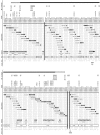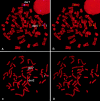The SPCH1 region on human 7q31: genomic characterization of the critical interval and localization of translocations associated with speech and language disorder
- PMID: 10880297
- PMCID: PMC1287211
- DOI: 10.1086/303011
The SPCH1 region on human 7q31: genomic characterization of the critical interval and localization of translocations associated with speech and language disorder
Abstract
The KE family is a large three-generation pedigree in which half the members are affected with a severe speech and language disorder that is transmitted as an autosomal dominant monogenic trait. In previously published work, we localized the gene responsible (SPCH1) to a 5.6-cM region of 7q31 between D7S2459 and D7S643. In the present study, we have employed bioinformatic analyses to assemble a detailed BAC-/PAC-based sequence map of this interval, containing 152 sequence tagged sites (STSs), 20 known genes, and >7.75 Mb of completed genomic sequence. We screened the affected chromosome 7 from the KE family with 120 of these STSs (average spacing <100 kb), but we did not detect any evidence of a microdeletion. Novel polymorphic markers were generated from the sequence and were used to further localize critical recombination breakpoints in the KE family. This allowed refinement of the SPCH1 interval to a region between new markers 013A and 330B, containing approximately 6.1 Mb of completed sequence. In addition, we have studied two unrelated patients with a similar speech and language disorder, who have de novo translocations involving 7q31. Fluorescence in situ hybridization analyses with BACs/PACs from the sequence map localized the t(5;7)(q22;q31.2) breakpoint in the first patient (CS) to a single clone within the newly refined SPCH1 interval. This clone contains the CAGH44 gene, which encodes a brain-expressed protein containing a large polyglutamine stretch. However, we found that the t(2;7)(p23;q31.3) breakpoint in the second patient (BRD) resides within a BAC clone mapping >3.7 Mb distal to this, outside the current SPCH1 critical interval. Finally, we investigated the CAGH44 gene in affected individuals of the KE family, but we found no mutations in the currently known coding sequence. These studies represent further steps toward the isolation of the first gene to be implicated in the development of speech and language.
Figures




Comment in
-
Chromosome 7q: where autism meets language disorder?Am J Hum Genet. 2000 Aug;67(2):278-81. doi: 10.1086/303034. Epub 2000 Jul 7. Am J Hum Genet. 2000. PMID: 10889044 Free PMC article. No abstract available.
Similar articles
-
Deletion of 7q31.1 supports involvement of FOXP2 in language impairment: clinical report and review.Am J Med Genet A. 2007 Apr 15;143A(8):791-8. doi: 10.1002/ajmg.a.31632. Am J Med Genet A. 2007. PMID: 17330859 Review.
-
A forkhead-domain gene is mutated in a severe speech and language disorder.Nature. 2001 Oct 4;413(6855):519-23. doi: 10.1038/35097076. Nature. 2001. PMID: 11586359
-
Localisation of a gene implicated in a severe speech and language disorder.Nat Genet. 1998 Feb;18(2):168-70. doi: 10.1038/ng0298-168. Nat Genet. 1998. PMID: 9462748
-
Support for linkage of autism and specific language impairment to 7q3 from two chromosome rearrangements involving band 7q31.Am J Med Genet. 2000 Apr 3;96(2):228-34. doi: 10.1002/(sici)1096-8628(20000403)96:2<228::aid-ajmg20>3.0.co;2-g. Am J Med Genet. 2000. PMID: 10893502
-
The importance of deep speech phenotyping for neurodevelopmental and genetic disorders: a conceptual review.J Neurodev Disord. 2022 Jun 11;14(1):36. doi: 10.1186/s11689-022-09443-z. J Neurodev Disord. 2022. PMID: 35690736 Free PMC article. Review.
Cited by
-
Language growth and genetics of specific language impairment.Int J Speech Lang Pathol. 2013 Jun;15(3):223-33. doi: 10.3109/17549507.2013.783113. Epub 2013 Apr 25. Int J Speech Lang Pathol. 2013. PMID: 23614332 Free PMC article. Review.
-
No Evidence for Recent Selection at FOXP2 among Diverse Human Populations.Cell. 2018 Sep 6;174(6):1424-1435.e15. doi: 10.1016/j.cell.2018.06.048. Epub 2018 Aug 2. Cell. 2018. PMID: 30078708 Free PMC article.
-
The human lexinome: genes of language and reading.J Commun Disord. 2008 Sep-Oct;41(5):409-20. doi: 10.1016/j.jcomdis.2008.03.003. Epub 2008 Mar 25. J Commun Disord. 2008. PMID: 18466916 Free PMC article. Review.
-
Genome-Wide Studies of Specific Language Impairment.Curr Behav Neurosci Rep. 2014;1(4):242-250. doi: 10.1007/s40473-014-0024-z. Curr Behav Neurosci Rep. 2014. PMID: 25411653 Free PMC article. Review.
-
Genetic insights into the functional elements of language.Hum Genet. 2013 Sep;132(9):959-86. doi: 10.1007/s00439-013-1317-0. Epub 2013 Jun 8. Hum Genet. 2013. PMID: 23749164 Review.
References
Electronic-Database Information
-
- Electronic PCR screening, http://www.ncbi.nlm.nih.gov/STS
-
- GeneMap ’99, http://www.ncbi.nlm.nih.gov/genemap (for radiation-hybrid map data)
-
- HGMP, http://www.hgmp.mrc.ac.uk (for PRIMER program)
-
- NCBI BLAST, http://www.ncbi.nlm.nih.gov/BLAST/ (for homology searches of sequence data)
-
- NHGRI chromosome 7–mapping data, http://genome.nhgri.nih.gov/chr7
References
-
- Ashley-Koch A, Wolpert CM, Menold MM, Zaeem L, Basu S, Donnelly SL, Ravan SA, et al (1999) Genetic studies of autistic disorder and chromosome 7. Genomics 61:227–236 - PubMed
-
- Barrett S, Beck JC, Bernier R, Bisson E, Braun TA, Casavant TL, Childress D, et al (1999) An autosomal genomic screen for autism. Am J Med Genet 88:609–615 - PubMed
-
- Bishop DVM, North T, Donlan C (1995) Genetic basis for specific language impairment: evidence from a twin study. Dev Med Child Neurol 37:56–71 - PubMed
-
- Bouffard GG, Idol JR, Braden VV, Iyer LM, Cunningham AF, Weintraub LA, Touchman JW, et al (1997) A physical map of human chromosome 7: an integrated YAC contig map with average STS spacing of 79 kb. Genome Res 7:673–692 - PubMed
Publication types
MeSH terms
Grants and funding
LinkOut - more resources
Full Text Sources
Other Literature Sources
Medical
Molecular Biology Databases
Miscellaneous

